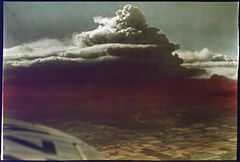
Back Vuurstorm Afrikaans عاصفة نارية Arabic Yanğın fırtınası Azerbaijani Огнена буря Bulgarian Tempesta de foc Catalan Ohnivá bouře Czech Çулăмлă çавраçил CV Ildstorm Danish Feuersturm German Tormenta ígnea Spanish
| Part of a series on |
| Weather |
|---|
|
|

A firestorm is a conflagration which attains such intensity that it creates and sustains its own wind system. It is most commonly a natural phenomenon, created during some of the largest bushfires and wildfires. Although the term has been used to describe certain large fires,[1] the phenomenon's determining characteristic is a fire with its own storm-force winds from every point of the compass towards the storm's center, where the air is heated and then ascends.[2][3]
The Black Saturday bushfires, the 2021 British Columbia wildfires, and the Great Peshtigo Fire are possible examples of forest fires with some portion of combustion due to a firestorm, as is the Great Hinckley Fire. Firestorms have also occurred in cities, usually due to targeted explosives, such as in the aerial firebombings of London, Hamburg, Dresden, and Tokyo, and the atomic bombing of Hiroshima.
- ^ Scawthorn, Charles, ed. (2005). Fire following earthquake. Technical Council on Lifeline Earthquake Engineering monograph. Reston, VA: American Society of Civil Engineers. p. 68. ISBN 978-0-7844-0739-4.
- ^ Alexander Mckee's Dresden 1945: The Devil's Tinderbox
- ^ "Problems of Fire in Nuclear Warfare (1961)" (PDF). Dtic.mil. Archived from the original (PDF) on 18 February 2013. Retrieved 11 May 2016.
A fire storm is characterized by strong to gale force winds blowing toward the fire everywhere around the fire perimeter and results from the rising column of hot gases over an intense, mass fire drawing in the cool air from the periphery. These winds blow the fire brands into the burning area and tend to cool the unignited fuel outside so that ignition by radiated heat is more difficult, thus limiting fire spread.